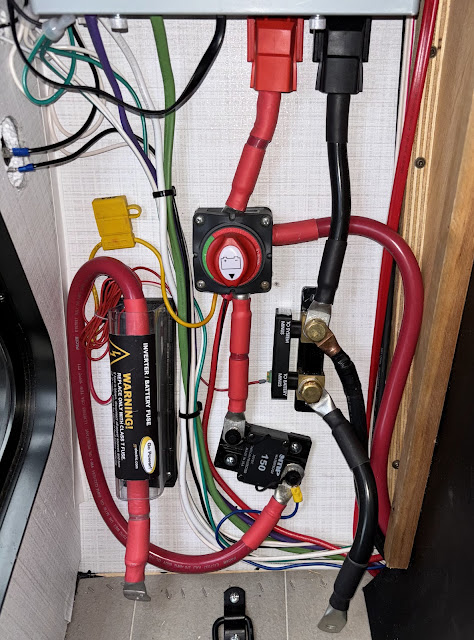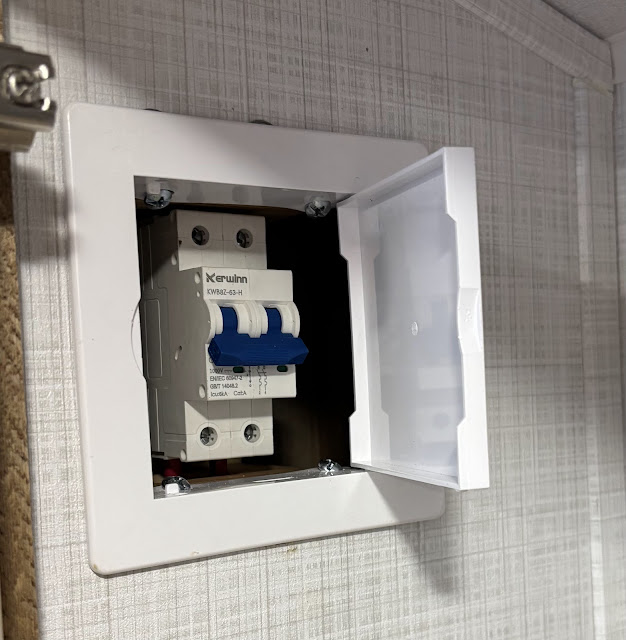Denisa wanted to include a blog post about the work that Mark did to get our trailer ready to do more boondocking without electrical hookups. She couldn't convince him to write a blog. So instead of getting a very informative technical piece that might be helpful, you're going to get a very layman's understanding of the work that Mark did, from Denisa's perspective.
Our Rockwood Geo Pro came with two regular lead-acid RV/marine deep cycle batteries and one 200-watt solar panel. The fact that it had some solar was helpful, but Mark wanted to add more solar and change the battery to lithium ion. That involved moving some of the parts and wiring and lots of planning. Denisa kept finding pieces of paper laying around the house that looked something like this:
It was also a little disturbing when Mark started cutting holes in the walls of our new trailer, and also cutting wires. But we should probably start from the beginning of the process.
Those two lead-acid batteries were in a box on the trailer hitch. But Mark wanted to move the new 280 amp-hour capacity lithium battery to a new location.
He did research to find that he could install a lithium battery on its end, and then it would fit in one of our side storage compartments. Lithium batteries need to be housed in an inside compartment that can be heated, because they can't charge when the temperature is below 32 degrees. Also, people are more prone to steal lithium batteries, so he wanted it inside a locked compartment. He also had to devise straps and latches to keep it up-right and secure when traveling.
With a new battery location, he had to run different cables to the new battery. But when he saw the trailer manufacturer's wiring layout, he called it a "rat's nest." Mark's an IT guy that has wired computers and telephones all over a college campus, and he likes neat wiring!
So he ended up moving all the wiring. He moved the battery on/off switch and circuit breakers and ground wire all inside, instead of out on the hitch. Now he could use shorter cables from the lithium battery switch to the inverter. He also relocated the ground, and added a class T (bigger) fuse for the lithium battery. He also had to move all the wiring to the solar panel. When he finished, that rat's nest looked much better.
Remember that hole in the wall? It became a cabinet for the solar panel circuit breaker. Before, there was no way to disconnect the solar panel from the controller. So adding this circuit breaker switch gives him the ability to kill all the power generated by the solar panel so he can work on things without getting shocked. That's also good when you have to remove the lithium battery in the winter, or when working on the solar panels.
At some point in moving things around, a fuse broke, and he found another one was cracked. So he had to buy new fuses.
Meanwhile, his drawings are getting more detailed and he's adding more notes. This is a complicated process!
Inside, he also added a shunt to the new victron monitor for the lithium battery, and relocated that wiring. Mark also had to lengthen the trailer jack wire.
The trailer came with a controller, mounted on the wall. After changing the batteries, Mark had to manually set the controller to let it know it is now monitoring a lithium battery. That involved setting the parameters to a different charge cycle. When Mark found out the firmware was on an older version, the company had to send a new controller that he had to install. This controller shows the voltage and amperage of the electrical system.

Mark found that getting the converter/charger to recognize the lithium battery was a challenge. He had to discharge the battery all the way, then charge it part way, stick out his tongue, stand on one foot . . . He was trying to explain to Denisa more technically, but she just understood that it was not an easy process.
Then Mark had to move to the roof. It's a good thing he had his electrical engineer grandson to help him!While our trailer came with one 200-watt solar panel, Mark doubled that by adding a second solar panel on the roof. That involved ordering the mounting hardware, more cables, connectors, and sealant. And of course, getting all that on the roof properly.
All of that had to be tested with devices that Denisa doesn't understand or recognize.

Mark also installed apps on his phone to monitor how much electricity the solar panels were producing, and how much charge the battery has. He was studying screens and writing himself notes about what changed when he turned different appliances on. That gave him a better understanding of the electrical usage and production.
When everything was finished and seemed to be working, it was time to document his work. So he labeled the pictures he took of some of the new cables and the old ones so he would know where they were leading.
The same goes with the new wiring closet that is no longer a rat's nest. Now he knows where all those cables are going.
Once again, Denisa doesn't understand all the work that Mark has been doing. But she certainly appreciates it! If anyone has any real questions about this project, Mark is obviously the one to contact.














Wow! That’s all I’ve got to say, just Wow!
ReplyDeleteThis is awesome!!!
ReplyDelete